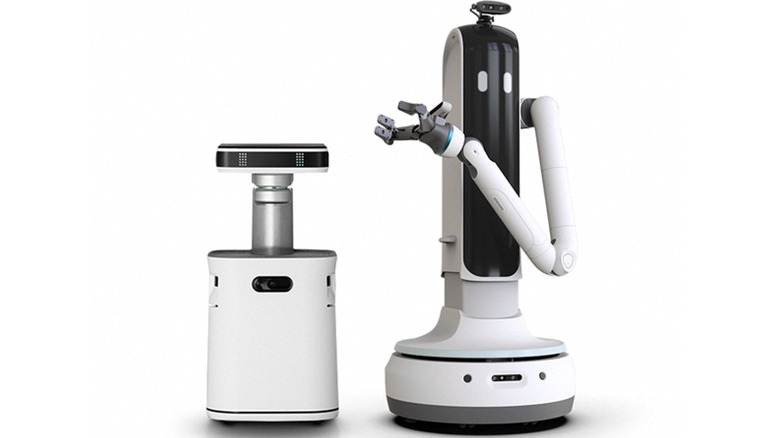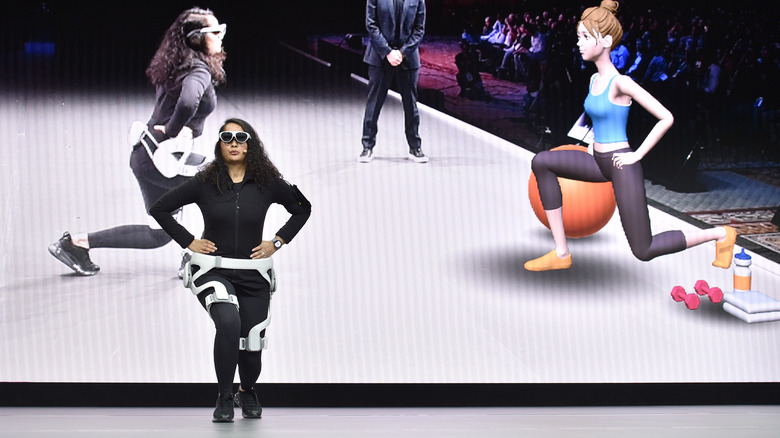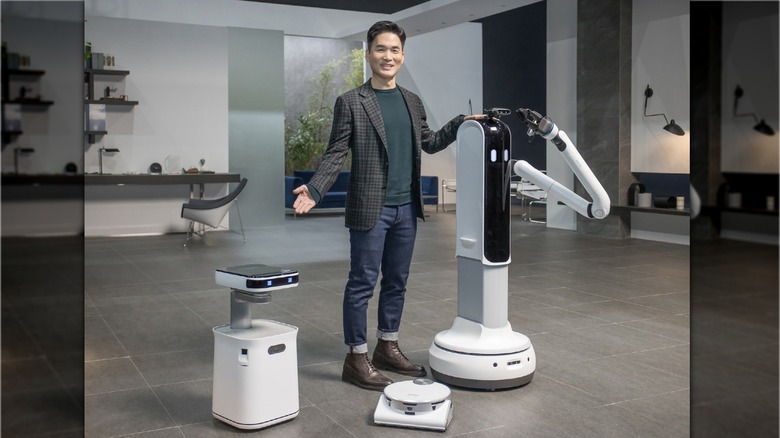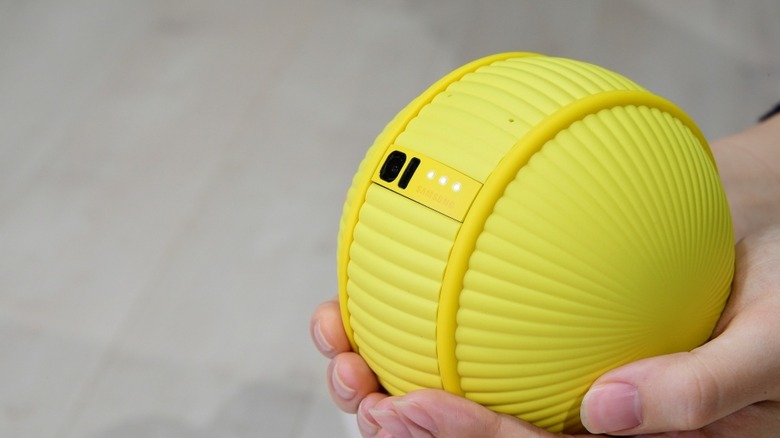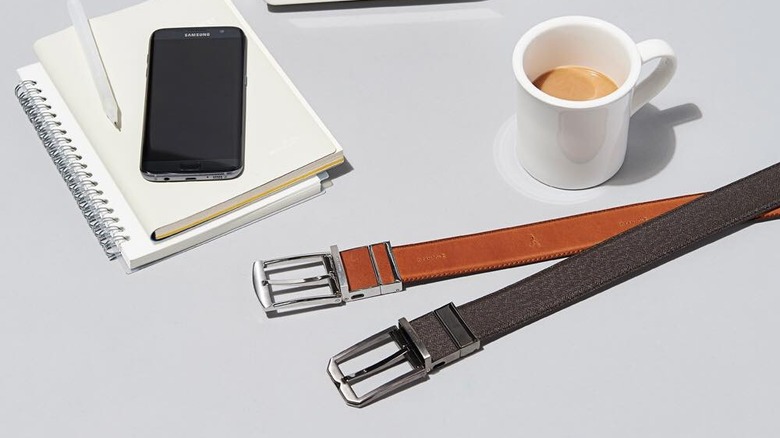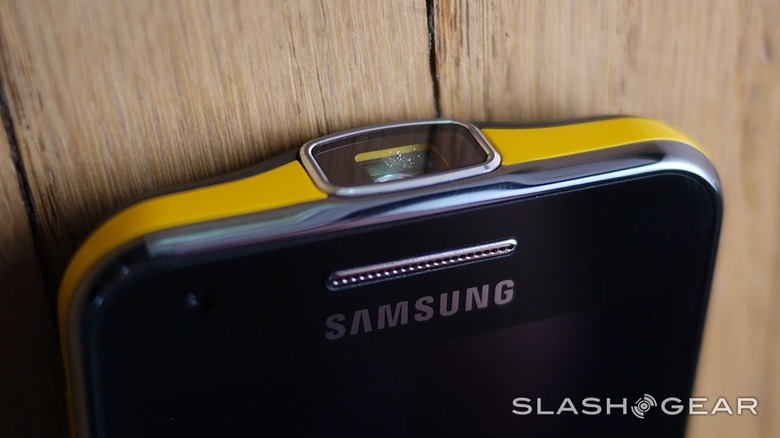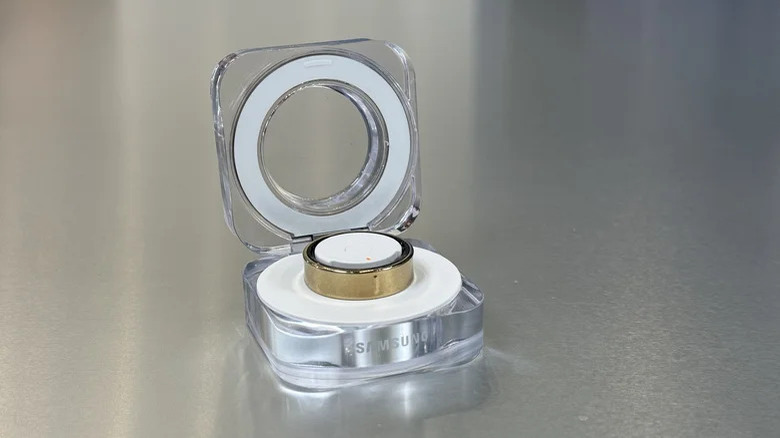10 Of The Weirdest Samsung Products Of All Time
We may receive a commission on purchases made from links.
The first Samsung products ever made were noodles. The latest is a ring. Their largest project is the world's tallest building. Most people hear the name of the Korean conglomerate and think of sleek smartphones, or perhaps refrigerators, but Samsung's ambition reaches far beyond microchips and touchscreens. Over its 80-year lifespan, the company has grown from the humble dreams of a single entrepreneur to a massive network of businesses which include smartphone manufacturers, construction companies, military contractors, and everything in between. From the bizarre to the bold, Samsung has made some incredibly weird products along the way.
Samsung produces so many things across so many categories that it's easy to see why it's the largest company in South Korea by a very wide margin. The word Samsung translates to three stars, which represents how varied the company's divisions were always intended to be. However, while the Samsung name appears on everything from skyscrapers to smartphones, the organizational structure of the conglomerate is atomized into 80 separate businesses, which gives each of those divisions the independence needed to invest in industry expertise and make unilateral decisions.
As the largest company in South Korea, there's hardly any part of the modern world Samsung hasn't touched, so from noodles to robots and smartphones to tanks, here are 10 of the weirdest Samsung products of all time.
Noodles
Today, Samsung is a dominant electronics manufacturing company. Not only does it make everything from refrigerators and robots to smartphones and laptops, but it even makes components for other companies, including the screens on nearly all iPhones. However, the company was far less grandiose in its early days. In 1938, Samsung began its life as a grocery store owned by founder Lee Byung-Chul. Its first big product wasn't based on silicon, but gluten. Samsung's popular noodles were made in-house at Lee's establishment. They were only the first of some strange and rare Samsung products.
Lee would soon expand his operation into textile and chemical production as well as manufacturing sugar and wool. Samsung wouldn't even enter the electronics industry until 1969. It's astonishing to consider how different the world would have looked had Lee never decided to sell noodles. Today, Samsung has shaped everything from military hardware to city skylines, all while acting as a major contributor to consumer technology as the biggest smartphone manufacturer in the world. All of those things happened because one man opened a grocery store, proving that humble beginnings can lead to greatness.
However, greatness might be an understatement for the current state of Samsung's conglomerate. Today, the company's revenue makes up around one-fifth of of South Korea's GDP, and is in many ways the most powerful entity in the nation. The Lee family has maintained control of this enormous economic entity by using snowball economics to scoop up innumerable other companies and fold them into the Samsung conglomerate. Today, Samsung has so much economic power that there is a South Korean saying – "What's good for Samsung is good for South Korea."
Howitzer tanks for the South Korean military
Samsung's structure – with lots of little Samsungs in various industries — have led its various branches to some unexpected places over the years, but none more unexpected than Samsung's military department.
Originally named Samsung Techwin and now known as Hanwha Techwin, this division is a major contractor for the South Korean military, and it has produced everything from amphibious assault vehicles to Howitzer tanks. The latter, known as the K9 Thunder, is a follow-up to the K-55, which was a Korean built variant of the American M109. It is a self-propelled, 155mm unit with a firing capability three times that of its predecessor at three rounds every 15 seconds. It also comes with bleeding edge mobility, including a 1,000 horsepower engine, and can reach speeds of up to 67 kilometers per hour.
Samsung was awarded a contract to develop the K9 Thunder in December 1998, and the first units made it to the Republic of Korea Army in 1999. It quickly became the envy of other nations, with variants being produced for the Turkish, Indian, and Australian militaries.
A massive hospital in Seoul
Samsung makes a lot of medical technology, so of course it needs somewhere to show those innovations off. To that end, and presumably with an added dose of altruism, Samsung has operated the Samsung Medical Center in Seoul, South Korea since 1994.
The hospital is truly massive, with a capacity of 1,989 beds, and it has treated over 2.3 million patients in its three decades of operation. It employs 1,297 doctors, which is nearly enough to assign a dedicated doctor to each bed in the facility. Of course, a hospital employs far more than just doctors, and Samsung Medical Center also boasts a nursing staff of 3,139, with an additional 865 medical technicians and a further 1,623 employees comprised of pharmacists, researchers, and administrative personnel.
Samsung Medical Center has helped to pioneer treatments in cell therapy, Gamma Knife Surgery, proton therapy, and other cutting-edge medical advancements. Its Comprehensive Cancer Center, which opened its doors in 2008, is larger than many entire hospitals all on its own, and in 2021 it performed 3,000 breast cancer surgeries, the largest number ever performed in a single year inside the country.
For a company so heavily involved in medical technology research, the Samsung Medical Center plays a vital and strategic role in Samsung's plans for the future. In 2010, the hospital established the Research Center for Future Medicine, where researchers in fields such as regenerative medicine, genetics, and cancer are looking for new breakthroughs. For example, in 2015, an initiative was launched revolving around genome-based personalized cancer treatment.
The tallest building in the world
Another of those not-so-tiny Samsungs is Samsung C&T, a contracting company that works on massive developments — and we're not talking about your local office park. Among other projects, Samsung C&T was the primary contractor for the tallest building in the world, the Burj Khalifa. Standing 2,717 feet tall from base to tip and spanning 163 floors, it towers above the Dubai skyline and is widely considered one of the UAE's greatest achievements.
While the Burj Khalifa was developed by Emaar Properties and designed by the Chicagoan architectural firm Skidmore, Owings & Merrill, Samsung C&T was the primary contractor for the construction of the tower. The building was even developed from early designs for the Samsung Tower Palace Three, a smaller building in Seoul. Samsung C&T's Ahmad Abdelrazaq was awarded the Ernest E. Howard award by the American Society of Civil Engineers for his work on the Burj Khalifa. Abdelrazaq also worked on projects such as the Star Residences, one of the tallest residential buildings in Malaysia, and the Merdeka 118, which is the world's second tallest building.
Samsung C&T is, in fact, the modern-day version of the trading company started by Lee Byung-Chul back in 1938, and is the main holding company for the Samsung conglomerate writ large. The C&T stands for Construction and Trading, but in fact, the company specializes in investments, fashion, and resorts in addition to the construction business. The Burj Khalifa is a far cry from hawking noodles, which goes to show just how massive Samsung has become since its founding.
GEMS
Samsung's enormity as a conglomerate allows it to make the wildest ideas of its employees come to life, and you can look no further than the bizarre looking Samsung GEMS, a robotic exoskeleton designed to help the mobility impaired. The company demoed the system at CES in 2019, where journalists got a chance to try it on, and while it might seem like a gimmick, media members who used the system were surprised to find that it actually works.
GEMS stands for Gait Enhancing and Motivating System. It straps around your waist and legs, then helps you move by providing some assistance to your motions. It's a bit like when your personal trainer at the gym puts a bit of pressure on your limbs to help you complete a challenging exercise. A Gizmodo reporter who tried the system said it felt like "walking [on] air" and that "it's easy to forget that the exoskeleton is even there since it's so light."
However, Samsung wasn't finished. In 2020, the company showed off a new version of GEMS, this time with AR glasses. The onstage demo featured a woman wearing an updated version of GEMS, then donning a pair of goggles to enter a virtual environment where the exoskeleton could adjust its assistive and resistant power to simulate hiking up a mountain or walking underwater.
At the second event, Samsung pitched GEMS as an exercise system this time rather than strictly a mobility device. In one sense, it makes sense to cater to the exercise market, which is far larger than the mobility market. Still, hopefully this device will still prove useful to the elderly and otherwise mobility impaired if it ever becomes commercially available.
Bot Care and other cute robots
You might not know that Samsung makes robots — a lot of robots, in fact, from fancy vacuum cleaners to personal assistants meant to roam around your house and hand you things. At CES 2021, the company held a virtual press conference during which it showed off a number of robots that all have increasingly weird and wacky designs. These were the JetBot 90 AI+, a vacuum cleaner bot, the Bot Care, an AI robotic assistant, and the Bot Handy, which has an arm and a claw and is meant to recognize objects around your house.
The first thing you'll notice about Samsung's robots is that they're clearly meant to be cute. The Bot Care is a prime example of this. At first glance, it looks like an air purifier with a projector mounted on top of it, but then its two digital eyes appear, instantly transforming it from a stormtrooper-white garbage can to a droid straight out of Star Wars.
Unfortunately, in Samsung's presentation, the first thing Bot Care does is nag its owner about being on the computer for too long, which is odd. Why is the computer telling someone to get off the computer? The top of its head then transforms into a pop-up monitor for conference calls, which is confusing since the laptop it scolded its owner for using could have accomplished the same task.
The Bot Handy, despite its awkward name, seems like the much more useful robot. It looks like a futuristic radiator on wheels and also has weird WALL-E eyes, but it uses AI to recognize objects and can actually do your dishes, which is basically the main thing we've wanted robots to do for decades.
Ballie, an AI smart home companion
The Samsung Ballie, another robot, seems a lot closer to becoming something you can pick up at your local Best Buy. Samsung showed off the little robot, aptly named for its bowling ball design, at CES 2024, and it seems like it might actually be useful.
The main concept of Ballie is that it has a projector built into the front of it and it can talk to you. The projector can throw information onto the closest wall, which was demoed by having a guy in a mock studio apartment exercise while Ballie projected video instructions onto the wall. There was a TV right in front of the guy, though, not to mention another large display in the Samsung smart refrigerator next to him, inadvertently demonstrating why Ballie might be a redundant product for most people.
Ballie then showed the guy his daily schedule by projecting that onto a different wall, which seems like it would take a lot longer than just opening the calendar app on his phone. Ditto for the little robot's ability to place phone calls, search for recipes, and most other things that were in Samsung's demo.
In fact, what makes Ballie so weird as a product is that Samsung makes so many products that work far better for the same tasks. Today, you can buy a Samsung Galaxy smartphone, a Samsung QLED smart TV, a Samsung smart refrigerator, and more. All of those things can show you your calendar, workout videos, and whatever else you'd ask Ballie to do. Samsung Galaxy productivity tricks are so polished after nearly two decades of innovation that Ballie feels like a much slower way to accomplish tasks you could already do with your smartphone.
A smart suit and a smarter belt
We aren't sure if smart clothing is the future, but Samsung was once at the forefront of that market. Its wearable brand, The Human Fit, made clothing that doubles as gadgetry. It's unclear whether The Human Fit is still in operation, as its website is defunct and its Facebook page hasn't been updated since January 2018, but before it disappeared Samsung was showing off attire including a suit that was smart in more than one sense of the word, with a belt to match. Both were created by Samsung's experimental Creative Labs division.
The smart suit, shown off at CES in 2016, is somewhat lackluster as a tech item. Unfortunately, the smart features of the suit consists solely of an NFC tag embedded in a button on the cuff that can be programmed to unlock your phone.
The smart belt, which Samsung also brought to CES in 2016, is a little more sophisticated, technologically speaking (fashion-wise, it looks like a pretty standard men's belt with a micro-USB port hidden in the buckle). In addition to monitoring steps and activity, which includes stats like distance moved, calorie intake, and sitting time, it will also keep track of your waist size by tracking how tightly fastened the belt is. Additionally, if you adjust the belt, it can use that information to figure out whether you're overeating. For diet-conscious folks, this could be a game changer, but others might find it off-putting.
Also a bit off-putting is the name. Samsung called it the Welt, which is presumably a portmanteau of wellness and belt.
Galaxy Beam
By Samsung's standards, a smartphone that doubles as a projector isn't that weird, but by any other metric it certainly is, and that's exactly what the Galaxy Beam, released in 2012, aimed to be. From the front, it looked like any other Galaxy smartphone from that era. Nor was it remarkable from the back, other than the fact of having a removable backplate and swappable battery. It was a bit bulky, even by standards of that time, but there were no other giveaways as to its gimmick.
Only when you checked the top of the Galaxy Beam would you notice the large maw of its projector lens. Did using the projector chew through battery life? Oh, yeah. It slurped down juice like a kid after soccer practice.
The ability to carry a large screen in your pocket is an incredibly tempting one, and something we've seen Samsung continue to chase after. Instead of a projector to make the screen bigger, the company now releases foldable phones like the Galaxy Z Fold 6 whose purpose is to make a tablet-sized screen as portable as a smartphone. However, while foldables are cool, there's nothing quite like pulling your smartphone out at a social gathering and commandeering a wall to project the vacation photos you're showing off.
A willingness to swing big on ideas like the Galaxy Beam is what has kept Samsung interesting over the years, so here's hoping they continue to make unhinged, freakish little gadgets like the Beam.
Galaxy Ring
Bringing us full circle to 2024, the newly announced Galaxy Ring, which SlashGear recently went hands-on with, joins the ranks of odd wearables made by Samsung. First shown off at the launch event for the Galaxy S24 series of smartphones, the Galaxy Ring was introduced at the end of the show in the manner of Apple's famous "one last thing."
It finally became available for purchase in July 2024 when it was officially launched at Samsung's Galaxy Unpacked event in Paris, France. Debuting alongside two foldable phones, a device category the company pioneered, the Galaxy Ring was a new accessory in the company's smart device ecosystem. It's essentially a set of fitness sensors arranged in a finger-sized circle. Pop it on your finger and it will monitor your vitals and fitness stats, which then syncs with the Samsung Health app on your Galaxy phone.
While the concept of a smart ring is not new — Oura has been making a similar product for some years — the Galaxy Ring does mark the first time a major smartphone manufacturer has stepped into that particular wearable category. Beyond that, Samsung is making some eyebrow raising claims regarding these little, titanium bands, such as the notion that they will use AI to monitor your sleep, heart rate, and activity, then blend that data together to create what Samsung calls an energy score.
It remains to be seen whether these features will work. After all, while Samsung has a remarkable track record in the medical technology field, AI is notorious for getting things wrong. Still, the Galaxy Ring is certainly the boldest product to come from Samsung in 2024, and the one product from the most recent Unpacked event that retains the company's experimental spirit.
